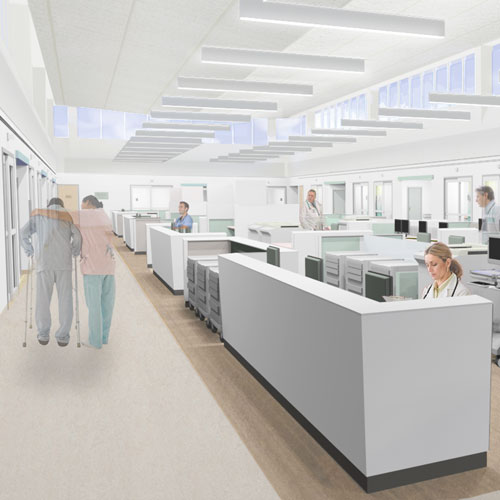A data center is the heart of any organization, an important nucleus filled with business applications running on interconnected servers, storage, secure networks, and IT systems. And though these facilities are critical and must never fail, leading companies lacking data-center experience or expertise often rush to build gargantuan spaces as quickly as possible.
With their company, Data Specialties, Inc., Phil Rafferty and Mike Shipman are providing an alternative method. Their design-build firm focuses on creating the data centers from A to Z, taking a collaborative, fact-based approach to guide clients through every step of the important process. Here, they break down their method in detail.

Q&A with Mike Shipman and Phil Rafferty
What’s one thing CIOs need to know about data centers?
Mike Shipman: We spend a lot of time educating executives, and as a result, they have a new level of knowledge, which supports needed changes resulting from their specific IT and data-center dynamics. They see value in the education we provide. Some, however, still think it’s as simple as throwing some equipment into a building
and/or colocation facility and walking away.
Data Specialties at a Glance
1991
established
50
employees
400
data centers
3M
total sq. ft. of floor space installed
2,000–10,000
sq. ft. per data-center space
$400K–$20M
cost range of data centers
Phil Rafferty: Everyone wants to know how they can drive down the cost of energy. What we preach is data-driven, resilient, and efficient design. Many factors applied in the design can reduce operational costs, and that’s what we strive for.
How dramatic are those reductions?
MS: We have a large manufacturing company that built a 20,000-square-foot facility 20 years ago. We were able to reduce their IT-data-center space down to 2,500 square feet but needed to more than double their power. They’re paying to cool much less space now, and their operational costs will be lower.
Are you building these spaces all at once?
PR: We talk to our clients about their long-term plan, usually asking about the next 5, 10, or 15 years. We build a road map, but we typically only build out the first phase by using a flexible, scalable modular model that takes us through a few years at a time. Usually, we build out the first five years.
What about colocation? Many companies are renting data-center space.
PR: We also build colocation facilities, and we know their strengths and weaknesses. In some instances, owning/building a data center is best, but DSI looks and considers all options and recommends the best option for each specific client. Whether it’s colocation, own/build, Cloud, or a hybrid of all three, we use the data to guide us and our clients in determining what is best for them. Many companies do not require the highest level of facility that colocation companies must provide in a multicompany shared-data-center environment.
Mike Shipman on …
Data Specialties’ Approach
We don’t start the process by asking clients how big of a data center they need. That’s the wrong question. In fact, we begin by gently challenging IT and facilities managers relative to what they think they need so that we help them avoid overbuilding their new data centers.
Our concepts are requirements-driven based on historical, current, and future IT and business needs. We are very consultative, and we understand both IT and data-center design and build. We apply decades of IT and data-center experience to provide the mission-critical facilities our clients actually need—only when they need them. Companies have come to us thinking they have a $10–20 million project on the table, and we can bring them a better project solution for substantially less investment.
As we go through this process, we work very closely with our clients and deploy an IT-data-driven consulting methodology. We then build and deliver the data center—including the training and maintenance at the completion of the build. Our clients typically want one company to do everything related to their data center, and that’s exactly what we do. Executives see great value in our ability to take an IT approach to designing and building their data center and also managing the process throughout all phases of the project.
The Data Specialties Consultative Process
1. Data Specialties’ leaders say that great projects are born out of understanding, collaboration, and relationships with clients. They begin each project discussion by breaking bread with key client executives to get to know them, their business, and their data-center needs. This usually occurs after an initial meeting with the client.
2. Rafferty and Shipman walk through the client’s facilities and spend time in two to three additional meetings to learn more about the client’s challenges, goals, and values.
3. A consultation period begins, during which Data Specialties uses data, works closely with the client, and builds an IT-requirements-driven road-map model for the data center.

4. Project leaders talk to representatives about the client company’s business applications, IT servers, storage, and other IT systems. A preliminary data-center budget and layout is developed.
5. The client company seeks approval from its senior management team and the board of directors.
6. Once a project is green-lit, Data Specialties produces a final conceptual design and engages engineers and its design team. For some projects, depending on location, it also partners with local firms.
7. A review phase begins as the company submits plans for peer and municipal approval.
8. Rafferty and Shipman’s delivery teams then place equipment orders and rely on strong relationships with several leading vendors in a brand-agnostic model.
9. Construction takes place.
10. When it comes time for testing and commissioning, Data Specialties brings in experts who try to break the system and expose any weaknesses.
11. Once a project is complete, Data Specialties trains its client to understand and ultimately operate the new facility. Then, it develops a custom maintenance program.
Top three Mistakes of Data-Center Construction:
• Hiring general practitioners to do brain surgery. Companies often engage design-build generalists when IT-data-center experts are required. Inexperienced contractors may build a facility, but that facility won’t be optimized for maximum efficiency, resulting in higher capital and operational costs, project delays, and/or crippling data-center failures.

• Miscalculating future needs. In the mad dash for space, companies often neglect to hire experts who will account for historical and future IT requirements using a modular-based approach. And, in the process, IT relocation costs, growth costs, and other hidden issues are also frequently missed.
Data-center footprints are shrinking as technology evolves, but cooling and power density are driving many changes. Companies that overlook these factors will be tearing out and replacing infrastructure years after an original build.
• Overbuilding the data center. Companies assume they need massive space, but Data Specialties is reducing existing facilities by as much as 70 percent during upgrades. Unnecessarily large spaces incur higher maintenance and operational costs.


